Multidimensional Body-Complex Structure (5): DNA Triplex & Cracking
YWS
(Third Edition, 2019 Public Edition)
--------Table of Contents--------
I. Overview of DNA History
1) History of Origin
2) Scope of Influence
3) Triple Helix Structure
4) Sensory Mechanism
II. Overall DNA Structure
1) Overall Function
2) Overall Structure
3) How to Crack?
III. DNA Group-1
- Functions, Structure, and Key Points of Decoding the First Set of DNA
- Trio 1
- Trio 2
- Trio 3
IV. DNA Group-2
- Functions, Structure, and Key Points of Decoding the Second Set of DNA
- Trio 1
- Trio 2
- Trio 3
V. DNA Group-3
- Functions, Structure, and How to Decode the Third Set of DNA
- Trio 1
- Trio 2
- Trio 3
VI. DNA Group-4
- Functions, Structure, and Key Points of Decoding the Fourth Set of DNA
- Trio 1
- Trio 2
- Trio 3
VII. Overall DNA Inhibition Parameters
1) Overall DNA Inhibition Parameters?
2) Overall DNA Cracking Ratio?
3) How is the DNA Cracking Ratio Calculated?
----------
As is well known, the human robotic body contains something called DNA.
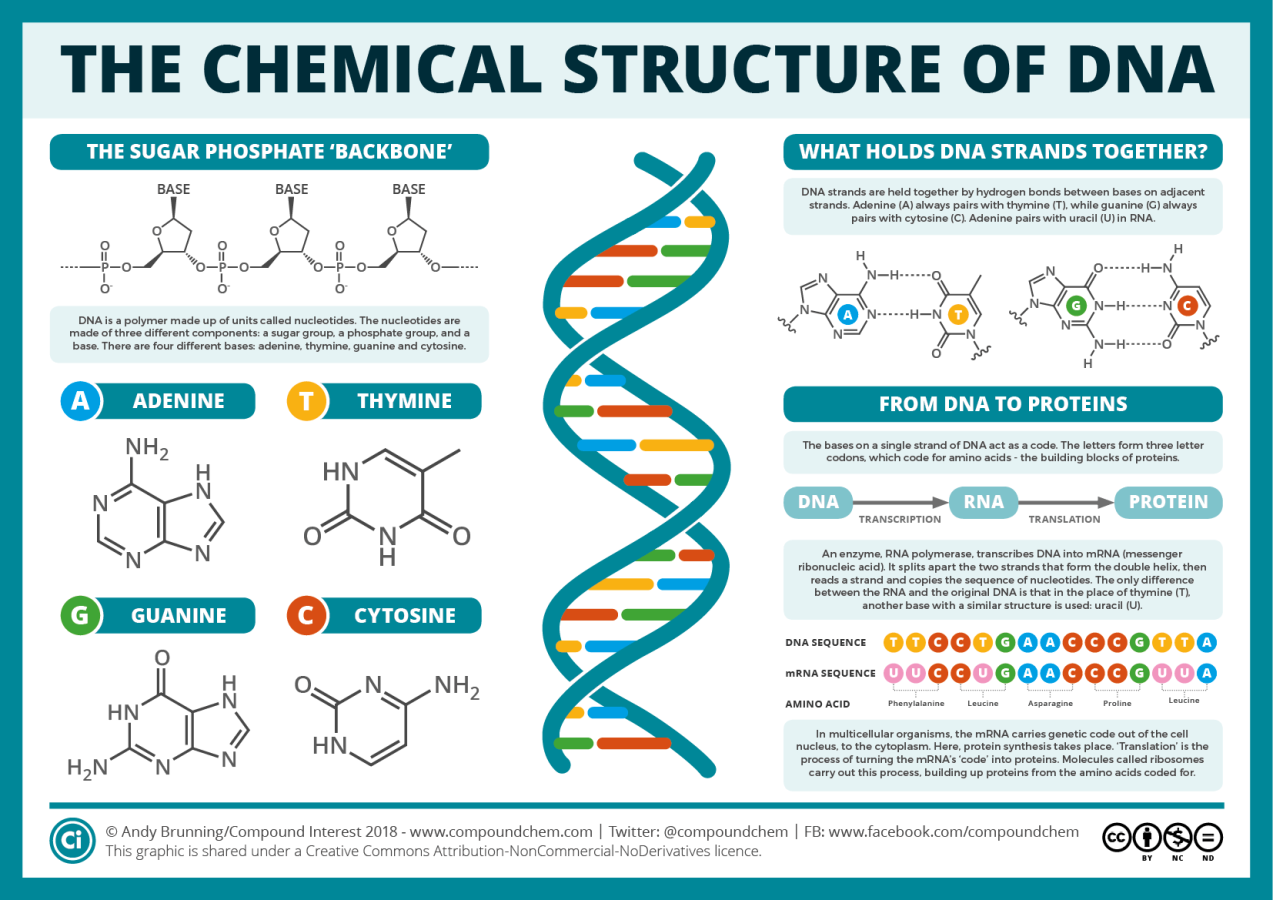
As shown in the diagram above, humanity has already conducted some research on physical DNA, so it will not be elaborated upon here. The following focuses on the aspects of DNA that humanity has not yet researched.
In the structure of the human multidimensional body-complex, there is also DNA.
From the physical body to the 2nd-10th spirit bodies to the spirit axis, all have DNA.
The spirit core may or may not have DNA, depending on the individual.
DNA is not an original fundamental component of the human body structure; rather, it is a special device implanted later.
In other words, DNA is a kind of "implant."
The original nature of DNA is a "game plugin" for robotic bodies.
Its purpose is to add additional restrictions to the functions of the robotic body, adjust the threshold parameters of these functions, and increase the difficulty of game, making it more challenging.
I. Overview of DNA History
1) History of Origin
Long before the birth of this material universe group, in the non-material universe group, a certain soul team (the organization that created this material universe group) began the development of the DNA template.
The original intention was to study the capability limits that pure souls could reach within certain permission restrictions, explore the possibilities of various extremes, play various extreme games, and create a template system for balancing permissions.
The original DNA template underwent many generations of development, with many different types of game technology teams participating in its research, upgrades, and modifications.
In the early stages, DNA was designed with four helices, but one was removed after development, leaving three.
Later, it was utilized by an organization called “1-Group” (a hypnosis strategy organization, a parent company of the T-Group, which operates the hypnosis reincarnation system), specializing in restrictive research, and has a long history.
(For more on the T-Group, refer to YWS article "What is Hypnotic Reincarnation.")
---
2) Scope of Influence
Currently, the influence of DNA extends to other universes, with the scope of implantation involving both the body and the soul.
- Body:
This refers to all robotic bodies. To a certain extent, DNA is treated as a special template or “implant” for the robotic bodies, in addition to robotic body’s “basic template” or “operation system”.
Robotic bodies that have not been implanted with DNA do not have the restrictions of this special template and can develop more freely.
- Soul:
DNA can also be implanted in a pure soul, serving as a kind of "consciousness template."
When DNA is implanted into a pure soul, there is a threshold limit related to the SoC (Strength of Consciousness). The pure soul needs to have a SoC of level 13 or below for the DNA implantation to be possible. If theSoC exceeds this level, DNA cannot be implanted.
(For more on SoC, refer to YWS article "What is SoC".)
3) Three-Helix Structure
Currently, the physical DNA observable by humans is a double helix, but there is actually a hidden helix - the third helix, forming an overall structure of three-helix.
The third helix is connected to the other two helices, forming a triangular shape that links the three helices together.
Inside the triangular structure, there is a program for adjusting function values, with its main functions being encryption, a hub, adjustment, and data buffering.
The third helix mainly encrypts and manages the first and second helices, as well as setting attributes, including encryption variable functions, variable thresholds, decryption and operation formulas, genetic variables, waveform transformations, and setting DNA permissions through non-material levels.
If the research on DNA only reveals the double helix and cannot detect the third helix, decryption becomes extremely difficult.
When viewed from a higher level, this triplex resembles the appearance of bubbles. The third helix is like a large bubble that encases the two bubbles (double helix) within it (as shown in the diagram).
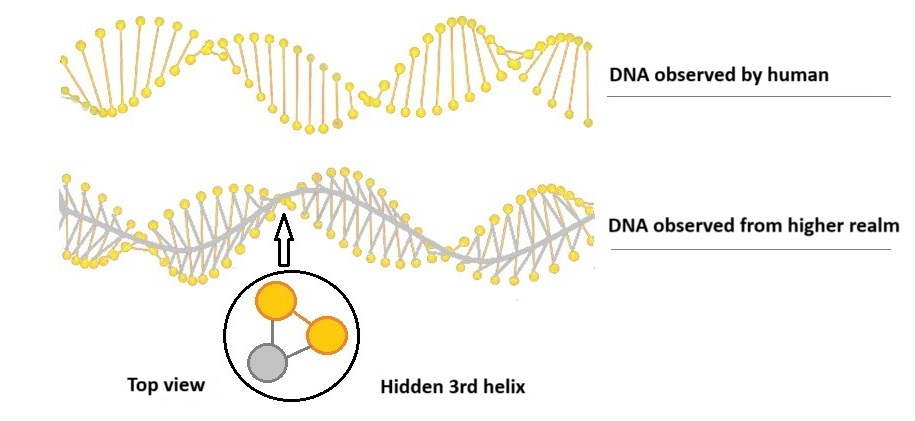
4) Sensory Mechanism
In the basic structure of DNA, there is a sensory mechanism: through this mechanism, similar and dissimilar DNA structures can exchange information between different individuals (similar to built-in wifi or quantum entanglement).
This sensory mechanism can operate through some preset programs, allowing external interferences to alter and modify information, and even change the structure.
Therefore, in later stages, due to the mutual cross-influence between different DNAs, various changes developed, sometimes leading to chaos, such as mutations and variations.
By modifying DNA data, it is possible to positively influence DNA or secretly alter it, similar to how a virus works.
1-Group and T-Group can use the DNA of one individual to infect the DNA of other individuals, achieving an effect of influencing and modifying the collective DNA.
DNA also has a protective mechanism against such modifications to suppress infection.
For example, it can block mutated information.
In the physical realm, this blockage can manifest as an inability to reproduce.
However, the protective mechanism of this sensory mechanism also has program loopholes. Therefore, some teams are conducting anti-infection research targeting these vulnerabilities and issues.
1-Group and T-Group have a long history of using this method to perform infectious hypnosis on DNA.
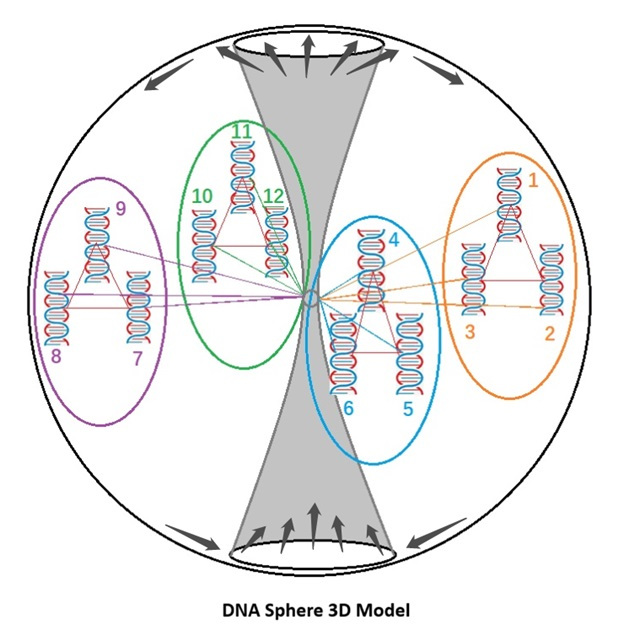
II. Overall DNA Structure
1) Overall Function
The overall function: Restrictive implants.
By embedding fixed and patterned program templates, these implants limit individual freewill and increase the difficulty and challenge of gaming. DNA templates are more intelligent, more scalable, and more fundamental than hypnotic devices.
*Implantation Method:
DNA templates involve internal static modifications at the fundamental level (while hypnotic devices involve external dynamic modifications).
*Contract Method:
Hypnotic devices are customized, with about 30% being non-voluntary. DNA is a more concealed, integrated implant, with about 40% being non-voluntary. The resistance to these implants by freewill is higher.
*Hypnosis Groups:
Currently, there are 3-4 main groups leading the implantation of hypnotic DNA: T-Group, 1-Group, S-Group, and a concealed Star Alliance (focused on research and technical support). These groups collectively dominate about 60% of the entire hypnotic game market.
*Non-Hypnosis Groups:
There are 7-8 groups, varying in size, some of which collaborate with T-Group, some operate independently, and some have split off from 1-Group. These groups collectively control about 40% of the entire hypnotic game market.
*Total Number of Individuals with Implanted DNA:
Approximately 2% of all tangible individual entities in the universe.
*Total Number of Hypnotized Individuals:
Approximately 0.7-0.8% of all tangible individual entities in the universe.
2) Overall Structure
The overall structure:
The entire DNA structure is like a sphere, with DNA distributed on the outer layer of the sphere, connected by lines to each other, arranged in 12 trios, sequenced from 1 to 12.
- The smaller the sequence number, the fewer the connections; the larger the sequence number, the more the connections.
- The 12 trios are divided into 4 groups, representing 4 levels of authority and relationships.
- The 1st group has the fewest connections to other groups, while the 4th group has the most connections.
- Within each group, the DNA trios are interconnected.
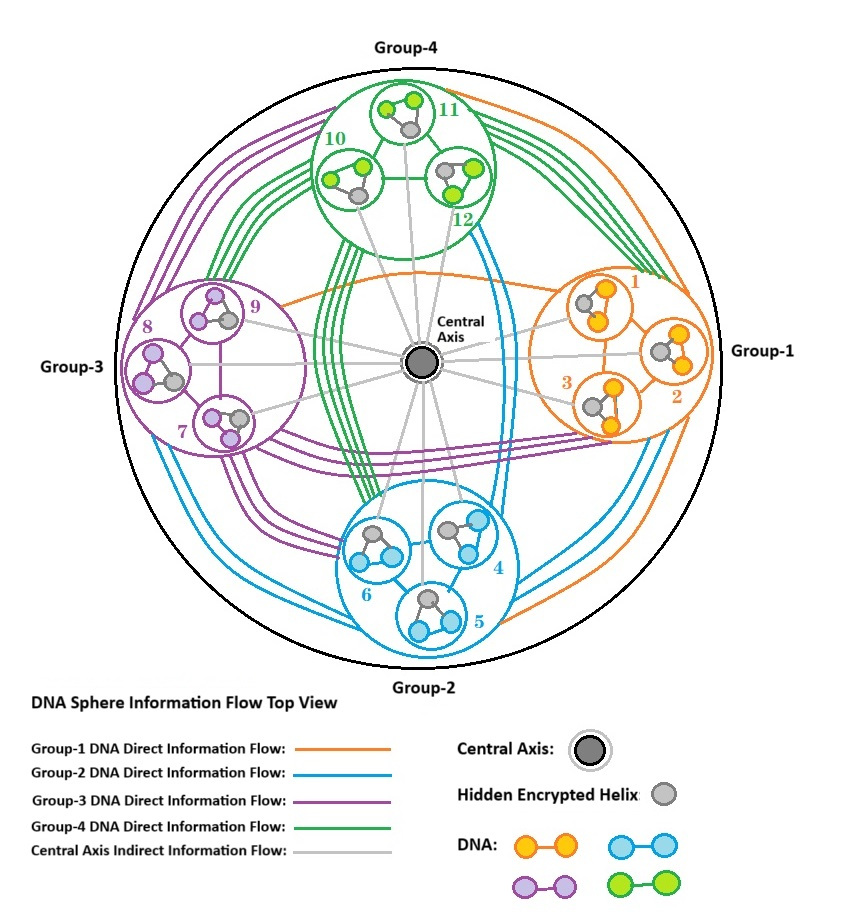
*Central Axis:
Similar to a spine, it runs through the center of the sphere, with many connections linking the DNA. Information is encrypted and processed through the central axis, then transmitted to other DNA.
-- DNA connections: Direct connections between DNA (multicolored) + connections through the central axis (gray monochrome). The central axis forms a closed loop at both ends, and the sphere is formed by these two ends of the central axis.
-- Energy supply: The sphere's energy is supplied by the central axis, radiating from both ends like the core of an apple.
-- Information transmission: It is encrypted through the central axis, forming the model of an energy center. Direct information flow between DNA is relatively slow, while indirect information flow through the central axis is faster.
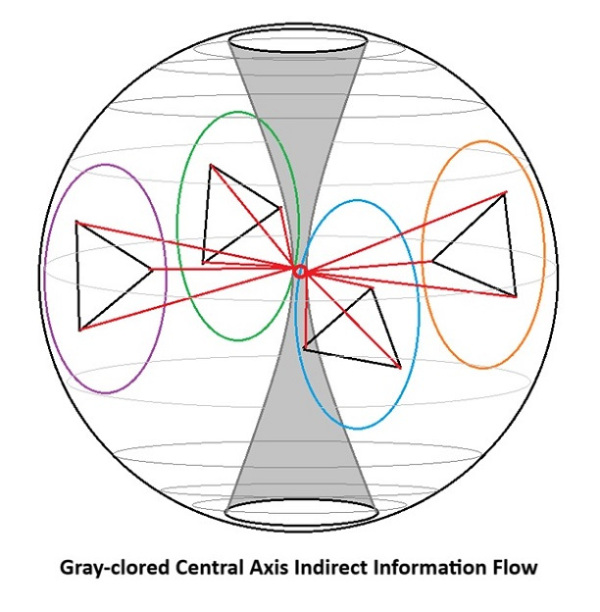
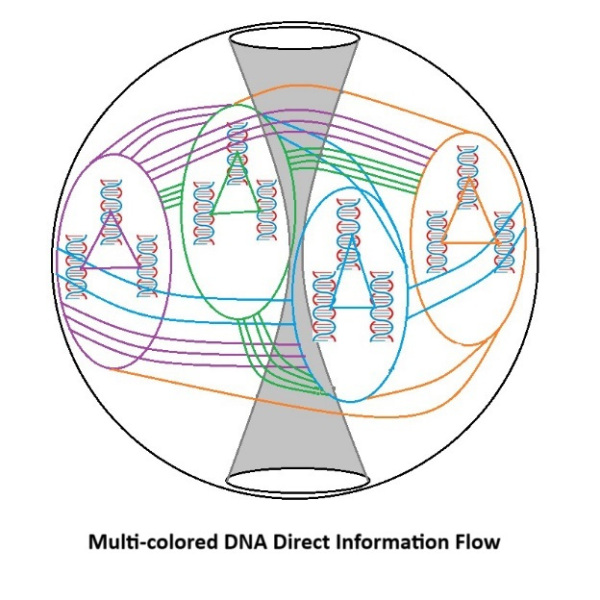
*Energy counterbalance ratio:
The speeds of indirect and direct information flows counterbalance each other - when one slows down, the other speeds up.
-- SoC: At level 14, the direct information flow is 100%, while the indirect information flow is 0% (no energy). The lower the SoC, the higher the indirect information flow.
At SoC level 1, the direct information flow is 0%, and the indirect information flow is close to 100%.
Below SoC level 1: Levels 1 to 0 approach to a state close to zero. Currently, there is no experimental data for an absolute level 0 and it is considered unattainable. The state close to level 0 is where all conscious particles’ movement or vibration approaches stillness.
The lowest experimental data from T-Group's hypnosis test is between levels 0.5 to 0.7, where the individual's dreams slow down during sleep, particle movement slows, and the difficulty of hypnosis increases exponentially.
*Case of the Proxima Centauri System:
Among the twenty or so planets in the closest star system to the Solar System, Proxima Centauri, half have been hypnotized, reducing SoC to as low as levels 0.8-0.9, primarily operated by S-Group.
(Group S is a small hypnosis organization that split off from T-Group, dedicated to developing stronger hypnosis techniques, conducting experiments in the Proxima Centauri system. T-Group did not participate in this system's hypnosis operations, as the hypnosis was too intense, and T-Group was concerned about the potential for significant freewill "backlash," which could have repercussions both technically and karmically.)
*Individual connections:
Different individuals have different spheres, with connections between individual spheres - both central axis and DNA connections (gray and colored links).
*Macro perspective:
Collectively, DNA forms a large sphere, within which there are countless smaller individual spheres, interconnected but with varying density. Less active small spheres concentrate near the central axis of the large sphere, while more active ones move outward.
-- The collective human DNA sphere and the collective animal DNA sphere are also interconnected as a whole. The "total DNA sphere" of various species simultaneously and overlappingly contains the various universes and groups of universes in which these species reside.
-- In other words, all DNA is interconnected, regardless of the species or universe, and is uniformly managed and regulated by a DNA committee.
3) How to Crack?
Key to cracking: Breaking the central axis information encryption.
By breaking the central axis, indirect information flow is reduced, direct information flow increases, and SoC increases.
The higher the SoC, the more automatic the cracking becomes.
*Cracking the central axis: can involve experimental methods such as shutdown, viruses, crashes, and disintegration.
*Overall binding: Each trio is connected by a central axis line, which acts as encryption to prevent tampering. It will automatically shut down when disturbed.
For example, when cracking the first DNA strand, because it is bound with other DNA strands, other parts will quickly and automatically repair it.
Therefore, an overall cracking is required to achieve the purpose of cracking.
For instance, first crack the large central axis, then the small central axis. If you crack a single strand, it will automatically repair itself.
This is also the T-Group's defense strategy.
The higher the SoC, the lower the difficulty of cracking, and only then can overall system collapse occur simultaneously.
Cracking Methods?
a) Cut off nutrients: The nutrient system is like the nutrient absorption system of a big tree. Cutting off branches will lead to automatic growth. The pivot point lies in nutrient absorption, which is the energy cycle mechanism of the entire system. A key node is in the middle of the large central axis, akin to an energy conversion point, an absorption and output point, relatively weak compared to the whole, and is a key point to crack.
b) Misalignment: At the energy cycle pivot and conversion center point - where absorption and output switch - it can be misaligned and unbalanced. When the imbalance is too great and out of sync, the AI’s automatic repair program will fail. Overall energy supply is the basis for DNA information synchronization; the more direct the information, the stronger the energy, and the more indirect the information, the weaker the energy. When the AI program detects an imbalance, it will automatically send energy to the weaker areas to achieve balance. Using this feature, creating erroneous information on the small central axis can transmit false information to the AI system, causing the AI to make incorrect judgments.
c) Cloning: Install a device at the conversion point to create information black holes and white holes, directly deceiving the AI, and then clone a large DNA sphere, causing information to be transferred to the cloned sphere, leading to complete desynchronization of absorption and output.
d) Discrepancy collapse: Lower the information to the minimum, then suddenly raise it to the maximum, creating strong fluctuation gaps that exceed the machine's tolerance, leading to system collapse.
*Overall plan:
A comprehensive plan is required, spanning three phases:
Step 1: Probe and lower the overall level, making the system mistakenly believe that the overall information is decreasing.
Step 2: Suddenly increase the information and observe the system’s emergency response, repeatedly doing so a few times to make the AI mistakenly believe the small central axis is chaotic, leading to misjudgment, and testing the system's tolerance.
Step 3: Suddenly reach the true maximum discrepancy, exceeding the tolerance level, causing the system to collapse.
*Simulated experiments:
Hundreds of simulations have been done before; the key is the second step, with a success rate of 58-60%. The 40% failure rate is due to incomplete severance; even if only 1% remains, it will automatically recover and reverse.
If the first attempt is unsuccessful, the AI will automatically learn, and its automatic defense mechanism will be generated, with defenses becoming increasingly stronger. The second attempt will then require a different approach.
---
III. DNA Group-1
Group-1’s functions, structure, and key points for cracking?
*Function: Attribute settings.
The primary role is to set attributes and exert inhibitory functions. It diversifies inherent abilities, placing some strong points in the later DNA groups and some weak and suppressive ones in the earlier DNA groups, thereby achieving more effective basic effects.
There is a hierarchical information link. The first trio already exerts significant inhibition on the individual and can achieve the purpose of suppression, which can inhibit the following two trios. Thus, the necessity of activating the subsequent DNA is very minimal (current human condition).
*Structure: Double helix structure + a hidden third gray helix.
The third helix functions as a central axis, primarily for encrypting the double helix.
The gray ends are connected to the overall central axis, serving encryption and shared information purposes.
The 1st, 2nd, and 3rd trios all have the same structure: the 1st connects to the 2nd, and the 2nd connects to the 3rd. The connections between the 1st and 3rd trios are minimal, indicating a hierarchical relationship. Compared to the other three sets of lines, it is relatively uncomplicated.
*Key points for cracking:
There are three straight lines in series, with the first trio at the bottom, forming a chain structure. Cracking must be done sequentially, either from 1 to 3 or from 3 to 1.
- Cracking method: Cut off the connecting line to another pair of DNA. After cutting, the gap might regenerate automatically, so a closed loop must be created at the gap, turning the straight line into a closed loop, causing the AI system to misjudge the cut as uncut. This closed loop needs to be completed quickly before automatic regeneration occurs, managing the timing difference effectively.
- Automatic regeneration time: Approximately one week.
Illustration:

---
Trio 1:
*Function: Basic attributes.
Includes gender, traits, character, personality, and inherent tendencies. These differ from the original tendencies of the soul and can be merged, hidden, or modified.
*Structure:
Provides information to the previous trio.
*Key points for cracking:
Same as above. Cut off.
*Inhibition parameters:
Human average: 90% (degree of inhibition). Uninhibited portion: Human average 2%.
*Sample data from random testing (degree of inhibition, same applies below):
Test Subject 2: 18%
Test Subject 3: 30%
Test Subject 1: 1%
Test Subject 5: 70%
Test Subject 6: 58%
Test Subject 4: 65%
Test Subject 11: 27%
---
Trio 2:
*Function: Additional attributes.
Increases tendencies such as skills, expertise, and strengths.
*Structure:
Acts as a bridge for information, carrying it forward and backward.
*Key points for cracking:
Same as above. Cut off.
*Inhibition parameters:
Human average: 97% (degree of inhibition, same applies below).
*Sample data from random testing:
Test Subject 2: 38%
Test Subject 3: 60%
Test Subject 1: 7%
Test Subject 5: 82%
Test Subject 6: 70%
Test Subject 4: 70%
Test Subject 11: 55%
---
Trio 3:
*Function: Expanding attributes.
Involves spiritual connections, high-dimensional non-material skills, and some basic attributes of the original soul.
*Structure:
Information extends downward from the top.
*Key points for cracking:
Same as above.
*Inhibition parameters:
Human average: 99%
*Sample data from random testing:
Test Subject 2: 50%
Test Subject 3: 67%
Test Subject 1: 11%
Test Subject 5: 89%
Test Subject 6: 85%
Test Subject 4: 76%
Test Subject 11: 68%
---
IV. DNA Group-2
Group-2’s functions, structure, and key points for cracking?
*Function: Information connection.
Primarily facilitates quick connection and distribution of various information sources.
The influence from T-Group is to mainly cause confusion and distortion during the connection process, affecting the quality of information transmission, which can lead to misalignment of information connections. Compared to plants and other animals, the impact on humans is currently more significant, placing them in a semi-dormant state. This is also one of the key direction of influence researched by T-Group.
*Structure:
T-shaped, resembling the Mercedes-Benz logo, with three DNA trios connected in the center. T-Group focuses on interfering with and inhibiting the three connection points.
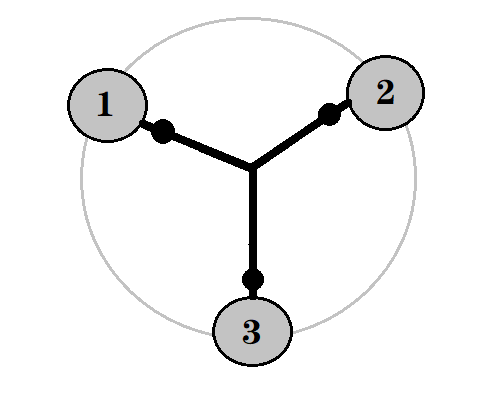
*Key points for cracking:
One method is to crack and clear the central point, allowing the three trios to form an undisturbed connection environment.
Another method is to deepen the interlinking of the three trios, forming a ring where the three points are placed on the ring, becoming the dominant information chain. The central point is weakened and left unused, and then gradually reconnected, re-encrypting the central point to make it difficult for the T-Group to crack. The ring formation is a more concealed approach, bypassing T-Group's monitoring programs, and creating an external information bridge, making it harder for T-Group to detect and creating a time lag.
The first method is a frontal attack, which is more challenging.
The second method is a clever maneuver, which is relatively easier.
---
Trio 1:

*Function: Classification of information sources.
Receives information, initially analyzes the attributes of the information source, organizes and classifies it into different levels, and sorts it by priority.
- Levels: Logical relationships of information (logical ordering), sequence (time factors, time ordering).
Mainly divided into two parts: reception and redirection.
*Structure:
Reception and redirection have a sequential relationship, with redirection resembling a tree-branch structure.
*Key points for cracking:
The T-Group influences the area after the redirection tree-branch structure, creating an overpass-like program during the process of categorizing information (A, B, C, D) for transmission. This causes confusion and misguidance, leading to disorder in linear information and reduced efficiency.
*Cracking method:
Similar to the key points of Group-2.
*Inhibition parameters:
Human average: 90%.
*Sample data from random testing:
Test Subject 2: 25%
Test Subject 3: 30%
Test Subject 1: 8%
Test Subject 5: 55%
Test Subject 6: 70%
Test Subject 4: 45%
Test Subject 11: 40%
---
Trio 2:

*Function: Provides driving force for information transmission.
The principle is similar to a high-speed rail power system. If damaged, information transmission will be very slow.
- Power sources: There are two points: one for reception and one for transmission.
- Reception: The power source has a line connected to the 1st DNA Group. The 1st Group's power source comes from the individual’s desire and willingness for information, connected to Trio-3 of Group-1. For information reception, there are two scenarios: active request for information or passive arrival of information. Whether to absorb the information depends on the individual's willingness to receive it.
- Transmission: The power source connects to Trio-1 of Group-3, with power coming from external forces driving information transmission to the individual. For information transmission, there are also active and passive scenarios.
*Structure:
A straight line, like a radio arc between two high-voltage lines, where both sides have certain power, forming a strong arc if power is high and a weak arc if power is low.
*Key points for cracking:
The T-Group has implanted programs between the two points to reduce voltage, like resistors or transformers, lowering current or voltage, or causing instability. This results in chronic power insufficiency or instability, weakening the intensity of strong intentions and slowing down information transmission.
*Overall cracking:
Same as above. Either forcibly remove the T-Group's program or build an external bridge to link the connection.
*Inhibition parameters:
Human average: 88%.
*Sample data from random testing:
Test Subject 2: 48%
Test Subject 3: 48%
Test Subject 1: 25% (Some of the power is actively redirected to handle certain matters. The normal parameter is 9-10%.)
Test Subject 5: 70%
Test Subject 6: 68%
Test Subject 4: 58%
Test Subject 11: 60%
---
Trio 3:

*Function: Information reception and processing.
- Reception: Similar to Trio-1: reception and redirection, but the reception direction differs, resembling a feedback system. When an individual needs to send out information, this is used for processing. It forms a symmetrical relationship with Trio-1, with similar functions but different directions.
- Processing: Packages the information source to be sent out, setting parameters like range, content, area, direction, point-to-point, or diffusion before sending.
*Structure:
The reception and redirection are similar to Trio-1 but include an additional transmission program.
**Key points for cracking:**
Reception and redirection are similar to Trio-1. The T-Group created an overpass here: during transmission, a misleading program is added to the packaging, causing confusion when sending.
*Cracking method:
Similar to the key points of Group-2.
*Inhibition parameters:
Human average: 95%.
*Sample data from random testing:
Test Subject 2: 37%
Test Subject 3: 40%
Test Subject 1: 7%
Test Subject 5: 76%
Test Subject 6: 65%
Test Subject 4: 55%
Test Subject 11: 40%
---
V. DNA Group-3
Group-3’s functions, structure, and key points for cracking?
*Function: Information processing capability.
It processes all received information in terms of depth, breadth, and degree of mixture. The higher the capability, the more useful information can be obtained.
- Degree of mixture: Involves connections, expansion, divergence, logical, and non-logical connections.
- Depth and breadth: Refers to the capacity value.
- Depth: Incremental depth of surface information, including both surface and deep meanings.
- Breadth: Percentage of information.
*Structure:
XYZ coordinates, depth + breadth + degree of mixture, forming an elliptical sphere. These three aspects influence each other.

*Key points for cracking:
The three values of XYZ form three lines, creating a triangular connection (represented by the red lines in the diagram) that restrict and constrain each other, similar to an electric current connecting three points.
- When the mutual attraction is weak, the coordinates expand.
- When the mutual attraction is strong, the coordinates shrink.
- Breaking this mutual attraction allows the three aspects to become independent, which is the ideal cracking result.
There is a measurement value known as the vacuum value/degree, representing the expansion and pressure of the elliptical sphere.
- Low pressure: Causes the ellipse to be irregularly concave.
- The pressure value balances against the three lines.
- The pressure value does not refer to the difference between inside and outside of the sphere but rather represents a comprehensive value of willingness, openness of consciousness, freedom, and objectivity.
*Cracking methods:
1). Increase the vacuum value/pressure, which leads to natural cracking and rupture.
2). Cut the connections restricting the three points, representing an external force cracking. This requires bypassing the program of the three lines. One line is connected to Group-4, and another line is connected to Group-3, which are involved in information and energy supply, and these two supply lines need to be cut.
3). Bypass them by inputting false programs and instructions, causing the three lines to receive erroneous instructions, forming a closed-loop energy. This makes the restriction system mistakenly think it is still operating normally when it is actually ineffective.
---
Trio 1:
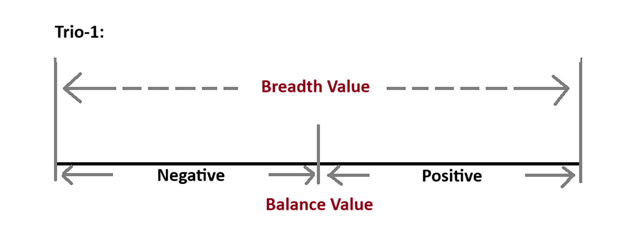
*Function: Breadth.
As described above.
*Structure:
Two values: breadth value and positive-negative balance value.
- Breadth value: Represents expansion capacity.
- Balance value: Indicates the degree of balance.
- Positive-negative: Represents the completeness of information. Two sides of information, two polarities, with no bias, purely objective balance. The positive-negative balance value also affects some parameters of the X value of Trio-3.
*Key points for cracking:
Overall, it is the same. More specifically, maintaining objective balance without interference is also a measure of DNA cracking/inhibition, i.e., the inhibition parameter.
Test Value = Breadth + Objectivity.
*Cracking method:
Overall, it is the same. Cracking a single trio has little effect, and its impact is not obvious. All three trios need to be cracked together as a whole. Cracking must be synchronized; otherwise, the automatic recovery function will increase the difficulty of cracking.
*Inhibition parameters:
Human average: 95%.
*Sample data from random testing:
Test Subject 2: 18%
Test Subject 3: 42%
Test Subject 1: 9%
Test Subject 5: 69%
Test Subject 6: 60%
Test Subject 4: 55%
Test Subject 11: 50%
Test Subject 16: 47%
---
Trio 2:
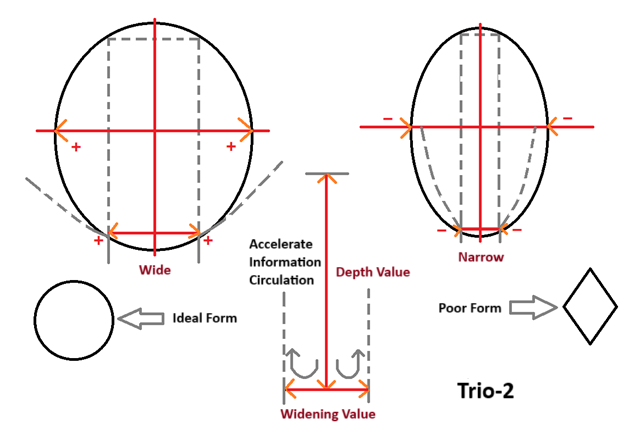
*Function: Depth.
As described above.
*Structure:
Two values: depth value and widening value.
- Depth value + Widening value: Similar to the tip of a tunneling drill, deepening and widening simultaneously. The better the dual values (depth value + widening value) are balanced, the stronger the capability to dig deeper. If information processing is slow, obstacles form at the tip, preventing further exploration. Similar to a large tunneling drill, with a disk-shaped multi-drill structure.
These two values determine the size of the disk. If information is processed promptly during the drilling process, it does not affect speed, thus preventing bottlenecks. Slow information processing affects the speed of deep drilling, leading to bottlenecks.
*Key points for cracking:
The key to cracking both values is to cut off the part of the values that was originally suppressed. The primary method is overall cracking, as mentioned above.
*Inhibition parameters:
Human average: 90%.
*Sample data from random testing:
Test Subject 2: 30%
Test Subject 3: 35%
Test Subject 1: 8%
Test Subject 5: 75%
Test Subject 6: 75%
Test Subject 4: 65%
Test Subject 11: 50%
Test Subject 16: 48%
---
Trio 3:
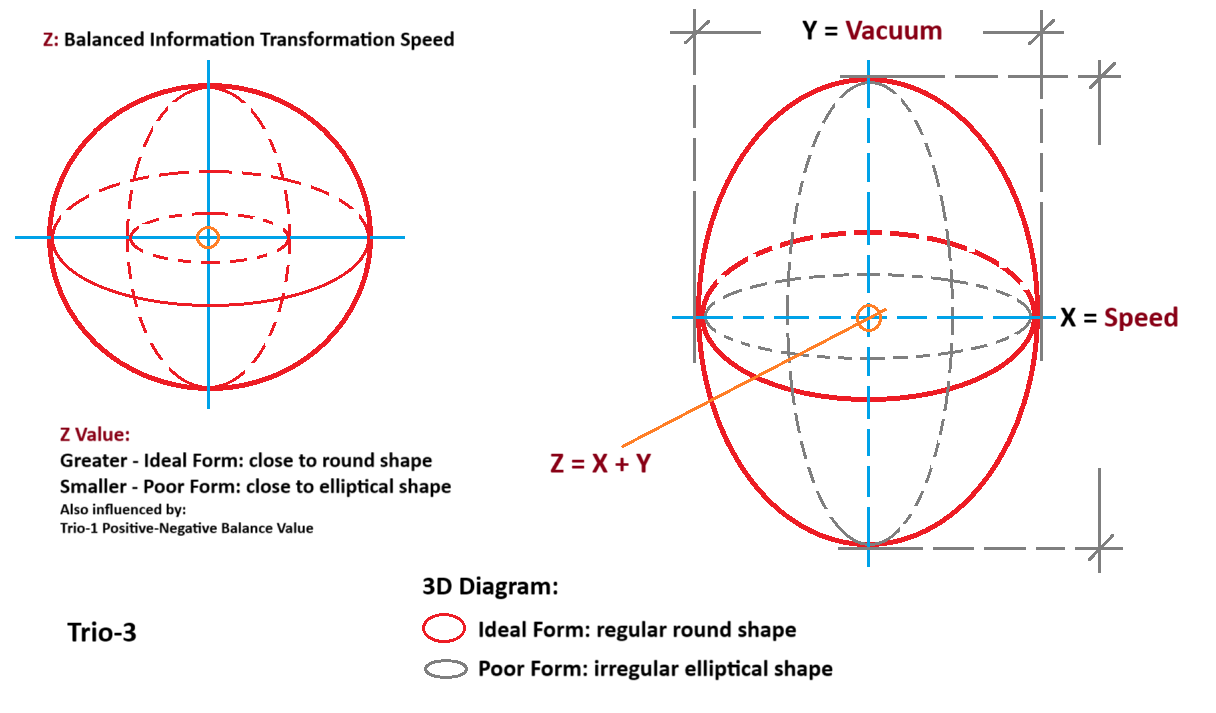
*Function: Degree of mixture.
As described above.
*Structure:
Interaction of several values.
The Z value consists of two values: X value (horizontal coordinate) and vacuum value (vertical coordinate).
The Z value represents the center of the diameter at the highest point of the ellipse.
*Different conversion rates:
1). X value: A rapidly rotating circular clock, representing the speed of information conversion. External information is needed to drive the speed. The faster the speed, the more balanced the X value axis is, resulting in a round shape (ideal form). Conversely, it results in an elliptical shape (irregular, poor form). This value is also influenced by the positive-negative balance value of Trio-1. The X value is reflected as the horizontal coordinate of the Z value, with no value when there is no information.
2). Vacuum value: Its maximum content is the objective value, expanding without directional restrictions based on this foundation. It does not require complex calculations and is the product of original values/core values/original independent values, requiring no external force to drive it. The higher this value, the greater the overall balance in all aspects, leading the elliptical shape to develop more symmetrically. This value is reflected as the vertical coordinate of the Z value.
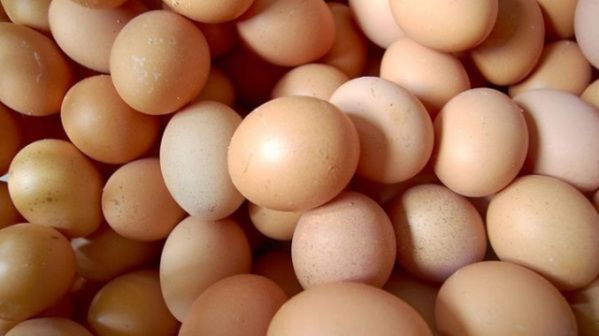

*Key points for cracking:
Overall cracking.
- Internal force: Increase the original value alone, leading to natural cracking.
- External force: As described above.
*Inhibition parameters:
Human average: 87%.
*Sample data from random testing:
Test Subject 2: 17%
Test Subject 3: 32%
Test Subject 1: 3%
Test Subject 5: 57%
Test Subject 6: 65%
Test Subject 4: 60%
Test Subject 11: 46%
Test Subject 16: 55%
---
VI. DNA Group-4
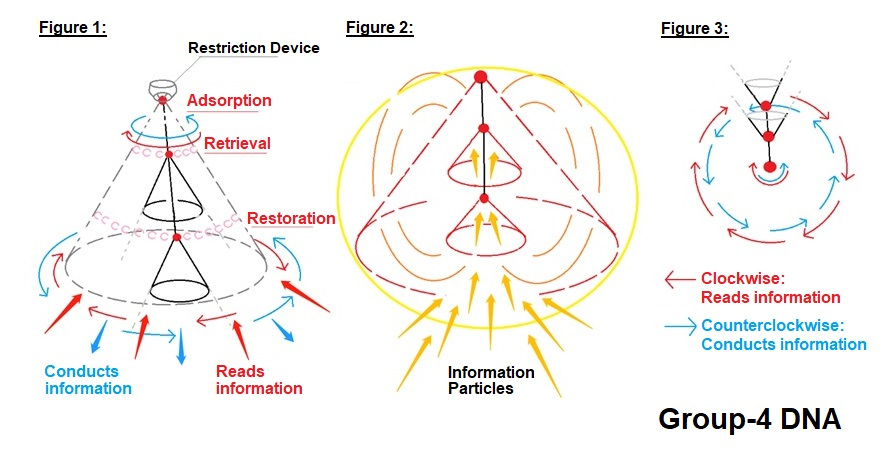
Group-4’s functions, structure, and key points for cracking?
*Functions:
1). Information Stickiness and Adsorption Ability:
Two antennas, one pointing up and one pointing down, with an empty space in between. Two electrodes interact in the middle, forming light blue bubbles. There are yellow bright spots in the middle of the bubbles, resembling lit light bulbs. Information stickiness refers to the ability to process various types of received information. For example, information adsorption ability (= storing soul memories in a specific space). The stronger the adsorption energy and the will, the easier it is for memories to be absorbed by the desired target. The deeper and older the memory, the greater the adsorption energy required. Fresher memories are easier to adsorb. There is a relatively proportional relationship.
2). Information Retrieval and Matching Ability:
The ability to extract distant memories, quickly match vast amounts of information, and find the information one needs.
3). Information Restoration and Authenticity:
Distant memories tend to deform and lose details. The higher the restoration percentage, the higher the completeness and authenticity.
*Structure:
A stacked structure model that overlays three functions: adsorption ability, retrieval ability, and restoration ability, with three beads lined up in a straight line.
- Dynamic Image:
Starting from the first point in the center, it moves like a pendulum, with the amplitude forming a fan shape. The greater the adsorption ability, the larger the swing amplitude and the stronger the ability. The greater the straight-line distance between the three beads, the larger the overall swing amplitude area. The retrieval and restoration themselves have a conical shape, with a pointed end facing up and a flared opening facing down.
The swing is not in a straight line; it rotates clockwise while swinging. When information particles enter, they rotate around the pendulum and approach the swinging point. Information flows like surrounding a large apple, being sucked up from the bottom flared opening and coming out from the top flared opening; then sucked in again from the bottom and out from the top, repeatedly circulating.
When swinging counterclockwise, information particles are expelled.
- Clockwise: Reads information.
- Counterclockwise: Conducts information.
Balanced rotation in both directions represents a normal state unless consciously controlled or interfered with. This is similar to the dual-directional operation structure of chakras.
The swing speed is initiated by the first point and determined by the other two points below, representing the speed of information processing. The speed has a gradually increasing cumulative effect.
The T-Group added a mechanism that restricts the freedom of movement, reducing the swing amplitude. Specifically, they added a bowl-shaped object that is inverted, limiting the maximum amplitude and speed of the swing.
*Key Points for Cracking:
1). All activations are subject to the first point's initiation, cracking and removing the restriction device of the T-Group.
2). The adsorption point is extended through an information pipeline to position it outside the restriction device, bypassing the device's program to render it ineffective.
3). Natural Cracking: If the swing amplitude force (SoC) is greater than the restriction force, the device will automatically fail.
*How can all memories be adsorbed? (How strong should the SoC be?)
1). Artificial Cracking: Through extensive practice of the key cracking points above, improve experience and proficiency to reach optimal levels.
2). Natural Cracking: The SoC of the physical body’s soul reaches levels 14 or above.
---
Trio 1:
*Function: Information adsorption ability, as mentioned above.
*Structure: As mentioned above.
*Key Points for Cracking: As mentioned above.
*Inhibition Parameters:
Human average: 99%.
*Sample data from random testing:
Test Subject 2: 78%
Test Subject 3: 75%
Test Subject 1: 47%
Test Subject 5: 89%
Test Subject 6: 93%
Test Subject 4: 88%
Test Subject 11: 90%
Test Subject 16: 91%
---
Trio 2:
*Function: Information retrieval function.
As mentioned above.
- Subcategories: Vertical, horizontal, abstract, concrete, macro, micro, multi-dimensional, multi-angle, random, directional, etc.
*Structure:
As mentioned above, forming a cumulative relationship, with values derived through accumulation.
*Key Points for Cracking:
As mentioned above. Unlock the peak state of all data, as a stationary state renders the function inactive.
*Inhibition Parameters:
Human average: 99%.
*Sample data from random testing:
Test Subject 2: 80%
Test Subject 3: 87%
Test Subject 1: 55%
Test Subject 5: 97%
Test Subject 6: 98%
Test Subject 4: 98%
Test Subject 11: 93%
Test Subject 16: 95%
---
Trio 3:
*Function: Information restoration function.
As mentioned above.
- Authenticity subcategories:
3 negative values: distortion, deformation, forgetting (time, dimension, abstractness, etc.);
3 positive values: realistic projection of the same experience, objective presentation, stability.
- Integrity subcategories:
Vertical, horizontal, multi-dimensional, multi-angle, non-attention/non-focal points.
*Structure:
As mentioned above, forming a cumulative relationship, with values derived through accumulation.
*Key Points for Cracking:
As mentioned above. Similar to Trio-2, through movement.
*Inhibition Parameters:
Human average: 98%.
*Sample data from random testing:
Test Subject 2: 80%
Test Subject 3: 80%
Test Subject 1: 39%
Test Subject 5: 95%
Test Subject 6: 95%
Test Subject 4: 96%
Test Subject 11: 90%
Test Subject 16: 96%
---
VII. Overall DNA Inhibition Parameters
1. Overall DNA Inhibition Parameters?
- Human Average: 90-95%.
Sample Data from Random Testing:
- Test Subject 2: 50-55%
- Test Subject 3: 65-70%
- Test Subject 1: 30-35%
- Test Subject 5: 80-85%
- Test Subject 6: 80%+
- Test Subject 4: 85-90%
- Test Subject 11: 70-75%
- Test Subject 16: 85-90%
2. Overall DNA Cracking Ratio?
- Human Average: 5-10%.
Sample Data from Random Testing:
- Test Subject 2: 30-35%
- Test Subject 3: 15-20%
- Test Subject 1: 50-60%
- Test Subject 5: 5-10%
- Test Subject 6: 5-10%
- Test Subject 4: 5-10%
- Test Subject 11: 20-25%
- Test Subject 16: 7-12%
3. How is the DNA Cracking Ratio Calculated?
It is not synchronized with the Inhibition parameters and exhibits a delay. Inhibition comes first, while cracking is delayed.
The Inhibition parameter is analogous to the depth of a tunnel that can be excavated, while the cracking ratio represents the actual depth of the tunnel that has been excavated.
The speed of excavation varies from person to person, depending on the ability to manipulate DNA functions, experience, and willingness.
---
*Note 1: All testing data in this document are from the period of June to October 2019.
*Note 2: For some test subjects, the SoC values assessed in the same year can be cross-referenced with the document "SoC AssessPoints: Test Sample Data 20190317" published by YWS.

----
YWS
©Copyright reserved.






